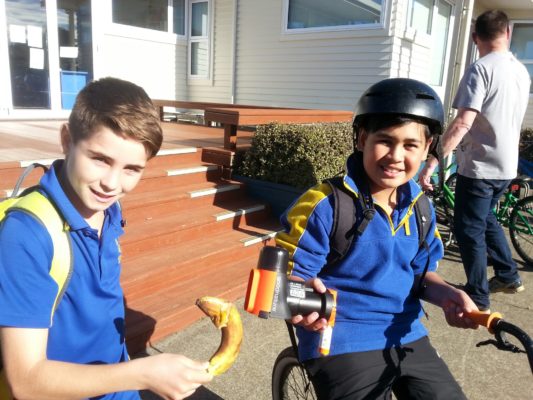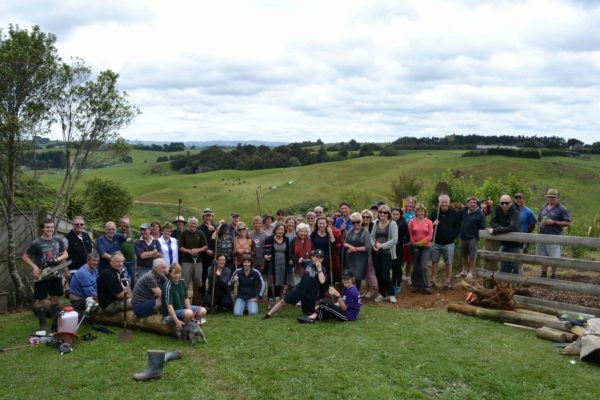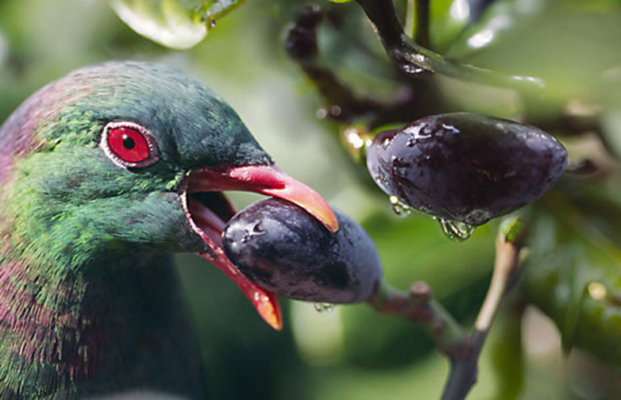A banana impersonated a rat and got mashed at a recent school assembly at Patumahoe – and the pupils along with many of their parents got a very visual, not to mention messy, demonstration of the humane killing power of Goodnature’s self-resetting A24 rat traps.

Volunteers from Kiwibank Predator Free Patumahoe were splattering banana across the school stage in a good cause. Not only do they want their town to be predator free – they also want pupils to have a healthy respect for trap safety.
“We’d been talking to the guys from Goodnature about promoting Health and Safety in schools,” explains Kiwibank Predator Free volunteer Andrew Sinclair, “They suggested a demonstration with a cucumber, but we didn’t have a cucumber so we thought we’d try a banana. It was spectacular! Banana went in all directions.”
Patumahoe School is playing a key role in the community’s predator free initiative, with pupils helping to make trap covers for other types of traps at a community working-bee held at the school.
“Not only is making our own trap covers cheaper than using commercially made ones, but it also promotes a sense of ownership and community buy-in,” says Andrew.

Patumahoe School has also been the pick-up spot for people collecting Goodnature A24 traps they’ve purchased at a discount through a Kiwibank Predator Free NZ subsidy.
“The trap subsidy has been very popular,” says Andrew. “We had a good uptake – all the traps were sold. The trick now is to remind people to stay active with trapping and pest control. It’s about making a permanent behaviour change. The challenge is how to keep people focused. Becoming predator free is about people-power,” he says, “Start with what you can do in your own backyard.”
Patumahoe’s predator free community project has been initiated by Whakaupoko Landcare, or ‘Bald Hill Possum Bashers’ as they were originally known, when the volunteer group formed 13 years ago. With an initial possum Residual Trap Catch index value of over 32%, mobilising their community to kill possums soon resulted in a tally of over 5000 dead marsupials.
Encouraged by their success – and by the sight of formerly dead-looking trees bursting into new growth, Whakaupoko Landcare evolved a bigger, more encompassing plan to enhance native plants and wildlife. Pest control was increased to include other introduced predators, revegetation projects initiated, stock fenced off from native bush, weed control carried out , a new community walkway built and regular monitoring carried out to record the results of their conservation efforts.

“Monitoring is important,” Andrew emphasises. “Results have to be more than anecdotal.”
Revegetation is monitored by taking photographs over time, pests are monitored with chew cards and birdlife is monitored by a simplified version of the 5 Minute Bird Count where the priority is just on easy-to-identify key indicator species.
“We monitor kereru, tui and fantail and now have 10 years of data with over 2,000 results” says Andrew. “They tell a simple story that both ourselves and funding agencies alike can understand at a glance.”
Kereru are doing particularly well in the Patumahoe area.
“In some of the bush areas close to Patumahoe, our 10 year bird surveys are showing up kereru at twice the counts as at Maungatautari Sanctuary which is completely predator free,” says Andrew. “Tui are at similar numbers (to Maungatautari). Who knows what will be the result if we do become Predator Free?”
Andrew attributes the success of kereru breeding to predator control and to the taraire trees that grow locally and have burst back into life now that possum browse is under control. The formerly skeletal, dead-looking trees are fruiting again and the high-protein berries are feeding kereru, not predators.
“In our area taraire and puriri once dominated the landscape. Kereru begin their first nesting in May to coincide with when the taraire berries begin to ripen,” Andrew says. “The berries last till the end of September and with food around the kereru have two nestings during this time when birds are not normally breeding. We suspect that some kereru are nesting up to 4 times in a year.”

With such visible success in the wider rural area, Patumahoe is keen to make their community completely predator free.
“It is exciting times,” says Andrew. “Everyone is really getting on board the Predator Free initiative and starting first with what they can do in their own back yard. Combined with the Goodnature traps, in the community there is now a network of rat traps with homemade tunnel boxes. Already there has been great success with the highest tally for one trap so far being 6.”
Andrew and his fellow volunteers at Whakaupoko Landcare are now working on ideas to keep that momentum going. One idea is to adapt the ‘giraffe’ fund-raising idea to show the growing community tally of dead rats.
“We’d also like to make plywood cutouts of native birds,” Andrew explains. “Then the people involved in Kiwibank Predator Free Patumahoe could have one hanging off their letterbox. It would give ‘ownership’ and focus on the positive (of birds being saved).”

